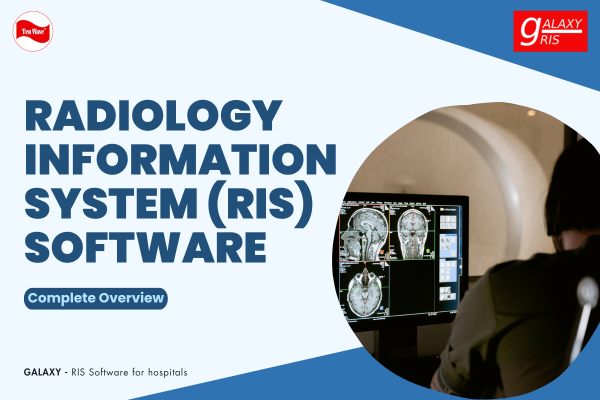In today's fast-paced healthcare environment, efficient data management is vital to provide prompt and precise treatment for patients. One crucial instrument that plays an integral function in this regard is Radiology Information System (RIS) software. It is important to understand the basic concepts of RIS and discover its role within the radiology department.
In this introductory guide, we'll explore RIS software for hospitals in more detail, highlighting its user-friendly features and how it benefits both healthcare providers and patients.
Whether you're a healthcare professional or simply curious about the inner workings of radiology departments, RIS software is a fascinating and essential aspect of modern healthcare that we'll explore together.
Understanding the role of Radiology Information System (RIS) in healthcare:
A Radiology Information System, commonly known as RIS software, is a specialized software system used in healthcare to manage and streamline the operations of radiology departments.
At its core, RIS is designed to organize, store, and facilitate the retrieval of patient information, medical images, and reports related to diagnostic imaging procedures like X-rays, MRIs, and CT scans.
RIS software forms the backbone digital of radiology departments at the hospitals and clinics. It's like an organized storage cabinet to store all the information associated with radiology.
The software helps health professionals plan, track and manage radiology appointments and procedures. It keeps vital patient information, including medical histories, images, and reports, in one central location, making it easy for radiologists and doctors to access critical data quickly.
Simply put, RIS software ensures that everything is running seamlessly behind the scenes to ensure patients receive the finest quality of care.
The Importance of Efficient Data Management in Radiology Departments:
Imagine a jigsaw without pieces. In healthcare, these missing pieces might include vital information about patients or the results of tests. RIS software can fill the gaps in information management.
It decreases the likelihood of mistakes, reduces the need for paperwork and improves the efficiency of radiology procedures. Through RIS software, doctors and medical staff can focus on the patient's care instead of administrative duties, which can result in more rapid diagnosis and better treatment outcomes.
Key Features of Radiology Information System Software:
Radiology Information System (RIS) software is an extremely powerful tool that aids healthcare providers in simplifying the various aspects of a radiology department. Explore its most important capabilities that are vital to ensure efficient operations and quality treatment of patients.
1. Appointment Scheduling and Patient Registration:
RIS software makes it easier to manage the scheduling of appointments by making it easy for healthcare professionals to schedule appointments, change schedules, or even cancel appointments with ease.
It also facilitates the registration of patients and secures your personal information as well as medical information and insurance information. It ensures a seamless registration process and reduces the need for the amount of paperwork.
2. Image and Data Storage and Retrieval:
One of the primary capabilities of RIS software is to store and retrieve radiology pictures and patient information. It is a central digital archive, which makes it easier for radiologists to access images from X-rays, MRI scans, as well as other images. The quick access to crucial data speeds up the diagnosis process and helps plan treatment.
3. Reporting and Results Distribution:
RIS software allows radiologists to produce accurate and thorough reports quickly. They can then be safely sent to physicians who refer patients. It ensures patients and medical professionals get timely information on their health condition.
4. Integration with Picture Archiving and Communication Systems (PACS):
RIS seamlessly integrates with PACS, which is accountable for storing and managing medical images. The integration ensures radiologists access relevant patient information, enhancing their ability to diagnose and improve overall patient care.
5. Billing and Workflow Management:
Achieving efficient workflow management and effective billing is essential in the field of healthcare. RIS software streamlines the billing process and insurance claims, making sure that radiology departments operate without a hitch and can be financially sustainable.
Advantages of Implementing Radiology Information System Software:
1. Improvement in Workflow Efficiency as well as Patient Care:
RIS software can be a game changer for managing radiology departments. It streamlines workflows and ensures that procedures, appointments, and reports are carried out effortlessly. This results in faster diagnosis, shorter wait times and, ultimately, improved the quality of patient care.
2. Increased accuracy of data and reduced Errors:
Data entry by hand can lead to mistakes that can compromise patient safety. RIS software can automatize information collection and administration, which reduces the possibility of making mistakes. Complete patient data and test results are easily available and aid in improved decision-making for healthcare professionals.
3. Improved communication among healthcare professionals:
In today's complex medical world, efficient communication is crucial. RIS software helps collaborate through the secure sharing of patient information and information between radiologists, doctors who refer patients, and other health professionals. This transparent exchange of information can lead to better-informed choices and better patient outcomes.
4. Cost savings and increased revenue:
Accuracy and efficiency go hand in hand with savings in cost. RIS software can cut down on administrative costs like paperwork and manually billed processes. Additionally, it helps optimize the allocation of resources. Furthermore, timely reports and diagnoses could increase referrals to patients and increase the revenue of radiology departments.
Conclusion: Radiology Information System (RIS)
In conclusion, implementing RIS software is a strategic move for healthcare institutions seeking to enhance their services. It not only improves healthcare workflow efficiency and patient care, but it also contributes to data accuracy, streamlined communication, cost savings, and revenue growth. RIS software is a vital tool in the modern healthcare landscape.
As we explore RIS software, In the next blog we will explore further How RIS Software Works and how to implement & Choosing the Right RIS Software to streamline the radiology department.
Tenwave Infotech - Best Healthcare IT company in India and software development company in India. We provide top Healthcare Software Solutions to improve healthcare industries. We are dedicated to transforming the healthcare management system with our healthcare IT services. Contact us Today!
How Can We Help you?


